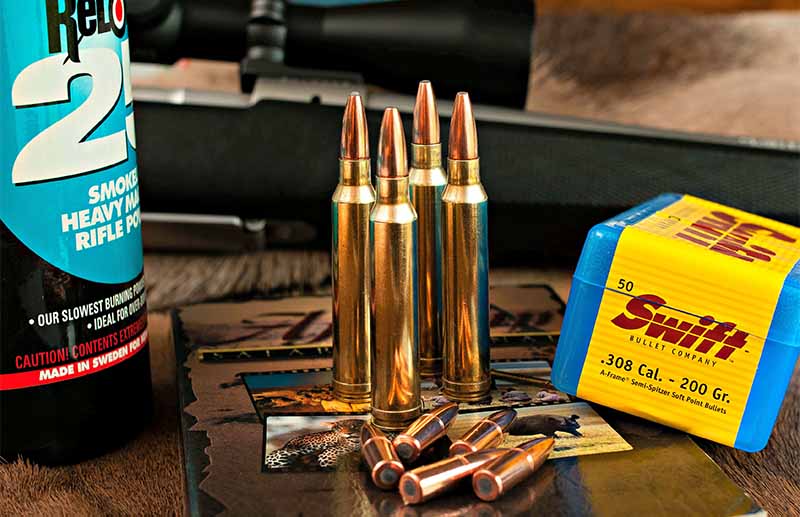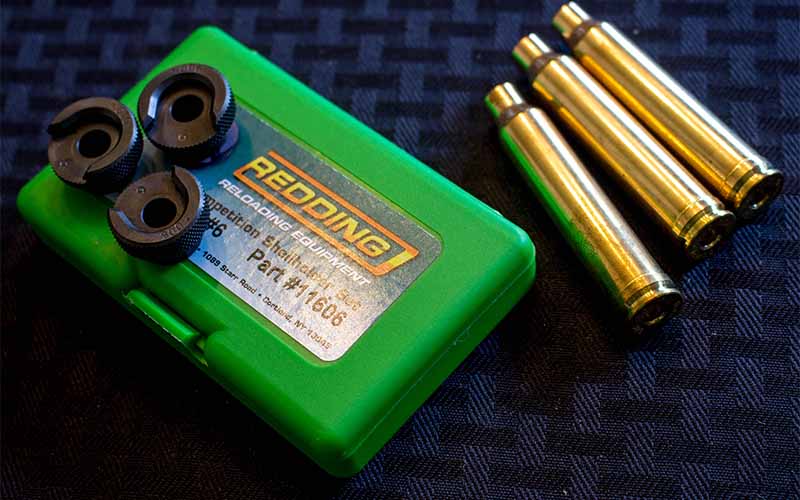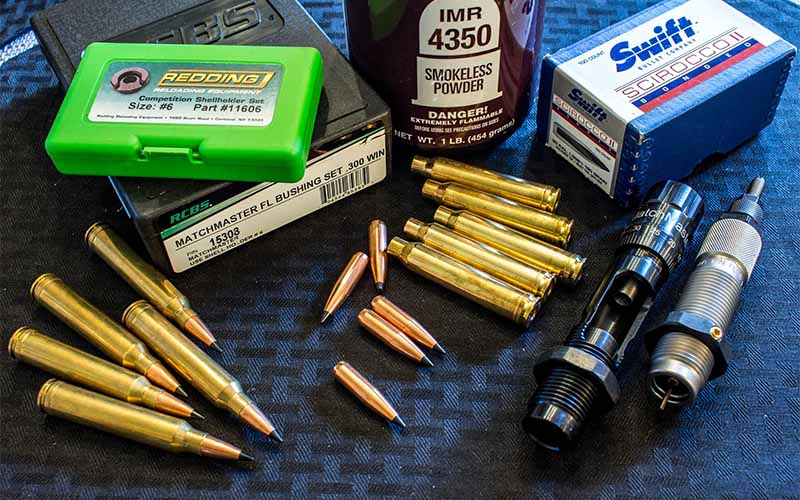
Despite its old-school design, there are still plenty of good reasons to keep reloading .300 Win. Mag.
If you look at the most recent cartridge designs, the 60-year-old .300 Winchester Magnum is the antithesis of modern trends. It’s belted, has a neck considerably less than one caliber in length, and it functions in a long-action receiver … yet the engineers moved the shoulder forward to increase case capacity. This last feature certainly allowed more room for powder, but it precluded the use of long, sleek bullets that have proven to give the best downrange results. These new bullets possess ogives so long that they can’t be seated in the .300’s case and still fit in the magazine.

Being a derivative of the Holland & Holland case, the .300 Winchester Magnum headspaces on the belt, and that can pose several issues. First, there will be stretching above the belt as the case is fired; this can be combated, as we’ll see in a minute, and it’s why I use fired brass cases when I’m getting serious about accuracy in any .300 Winchester. Second, the 25-degree shoulder can provide excellent headspacing, so long as you don’t move that shoulder too much during the resizing process.
Many claim that short neck fails to give proper neck tension, yet I’ve never had an issue in the thousands of rounds I’ve loaded. Unlike some modern designs, many projectiles will extend considerably below the neck/shoulder junction, and that can have an effect on the space left for the powder column. As the neck of the .300 Winchester measures just 0.264 inch, the idea of neck sizing—in order to keep the shoulder where it gives best concentricity and headspacing—might not be the best solution.
Instead, I much prefer to measure the amount of shoulder movement by using Redding’s Instant Comparator to give me the difference between the SAAMI specification and the fired case. I can then use one of Redding’s Competition Shellholders, which are graduated in increments 0.002-inch deeper than a normal shellholder, to be able to resize the case diameter and neck fully, while leaving the shoulder in the spot that gives the best headspace and concentricity. Using this method also reduces case stretching significantly, extending case life.

The .300 Winchester Magnum can use a heavy powder charge, sometimes over 80 grains, and runs best when sparked with a large rifle magnum primer. I’ve come to rely heavily on Federal Gold Medal Match primers, and a GM215M primer is my go-to: The consistency of these primers plays a definite role in keeping velocity spreads low.
Building With Bullets
One of a .30-caliber is the wide selection of projectiles available, in both weight and conformation. Common bullets range between 125 and 220 grains, but despite my best efforts with traditional 125-grain bullets like the Nosler Ballistic Tip, I feel they’re too light for the velocity generated. And unless it’s of premium construction—like the 130-grain Barnes TTSX—most bullet choices will begin at 150 grains … and even then, things can get messy if it’s a cup-and-core design.
The copper monometal and alloy projectiles, being longer than their lead core counterparts of the same weight, will give satisfactory hunting performance at 150 grains; there are traditional choices like the Barnes TTSX, or boutique choices like the Badlands Precision Bulldozer 2, that come in at this weight. Both offer excellent field performance and will expand reliably at any sane hunting range. These 150-grain bullets can be loaded to 3,300 fps, and I’ve seen a chronograph read 3,400 fps.
With bullets between 165 and 220 grains, you’ll see the .300 Winchester really shine as both a hunting and a target cartridge. Though many have made the switch to various 6.5mm cartridges or larger, and newer .30-caliber cartridges for target or competition work, it wasn’t that long ago that the .300 Winchester Magnum was revered as a target cartridge.
U.S. Navy SEAL sniper Chris Kyle—immortalized in both print and film—relied heavily on a .300 Winchester Magnum based on a Remington 700 action. Load your .300 Winchester with match bullet, such as the 178- or 195-grain Hornady ELD Match, 176-grain Hornady A-Tip Match or 175-grain Sierra MatchKing, and you’ve got a formidable combination. All can be loaded to a velocity that will keep them supersonic out to 1,500 yards, and if you want a cartridge to pull double-duty for target and hunting work, you could do a helluva lot worse than the .300 Winchester.
For the hunter, bullets between 165 and 220 grains make one of the most flexible packages available. There are too many wonderful hunting bullets offered in component form to list here, though I’ve come to favor more than a few: Federal Trophy Bonded Tip and Terminal Ascent, Sierra GameKing, Swift Scirocco II and A-Frame, Hornady’s Interlock (both round nose and spitzer), and Speer Grand Slam.

Fueling The Fire
During the past two decades, I’ve used Reloder 19, 22, 23, 25 and 26, IMR 4064, 4350 and 4831, Hodgdon H414, H4350, H4831SC and H1000, in addition to others. You’ll want a powder on the slower side of things, without needing to use so much that the load is heavily compressed. I like a column that takes up about 90 percent of the available volume.
For reloading dies, the .300 Winchester Magnum warrants the best you can afford. I like the RCBS MatchMaster Bushing Dies and Redding’s Type-S Bushing Dies; both have a micrometer-adjustable seating die, and both offer a sizing bushing that can minimize excess stretching of the neck.
The .300 Winchester Magnum is one of those cartridges that has fantastic accuracy potential with factory ammunition, and gets even better with handloads. Despite the recent lack of favor for belted cartridges, the .300 Winchester still shines, and if you’ve got a rifle you love, it’s easy to cook up a handload that’ll engender all sorts of confidence.
Pay a bit of extra attention, and you’ll more than likely end up with a tack driver.
Editor's Note: This article originally appeared in the December 2023 issue of Gun Digest the Magazine.
More On Reloading:
- Tips For Reloading the .30-06 Springfield
- Loving Your Luger: Reloading the 9mm Luger
- Handloading: Tips For Reloading The 7mm Rem Mag
- How To: Tips For Reloading the .223 Remington
- Reloading Bench: The Inside On Reloading For The .30-30 Winchester

Next Step: Get your FREE Printable Target Pack
Enhance your shooting precision with our 62 MOA Targets, perfect for rifles and handguns. Crafted in collaboration with Storm Tactical for accuracy and versatility.
Subscribe to the Gun Digest email newsletter and get your downloadable target pack sent straight to your inbox. Stay updated with the latest firearms info in the industry.

![Best Concealed Carry Guns In 2025 [Field Tested] Wilson Combat EDC X9S 1](https://gundigest.com/wp-content/uploads/Wilson-Combat-EDC-X9S-1-324x160.jpg)


![Best 9mm Carbine: Affordable PCCs [Tested] Ruger Carbine Shooting](https://gundigest.com/wp-content/uploads/Ruger-Carbine-Shooting-100x70.jpg)
![Best AR-15: Top Options Available Today [Field Tested] Harrington and Richardson PSA XM177E2 feature](https://gundigest.com/wp-content/uploads/Harrington-and-Richardson-PSA-XM177E2-feature-100x70.jpg)
